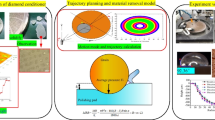Abstract
The purpose of this study was to investigate the chipping modes produced in the die edges of dicing silicon wafer using the thin diamond blades. The effects of dicing directions and different wafer types on the chipping size were studied. Furthermore, scratching tests were also used to assist the analysis of studying chipping conditions of the silicon wafer. The experimental results showed that the trace behaviors produced by the diamond indenter in the scratching test of silicon wafer can be divided into the three stages: rubbing, plastic deformation, cracking. The plastic pile up and crack of the scratching traces on the wafer mainly propagate along the development of the easiest slip direction family <110>. The chipping modes produced in dicing silicon wafer can be broadly classified as four types: (1) 30° chipping; (2) 60° chipping; (3) 90° chipping; (4) irregular chipping, which causes these mechanisms of chipping modes due to the meeting between the radial cracks of 30°, 60°, and 90° along the easiest slip direction family <110> and the lateral cracks along the easiest cleavage plane family {111}. When using the thin diamond blade diced on the (111) silicon wafer along the \( {\left[ {\overline{1} 10} \right]} \) direction, the size of top chipping produced was smaller than that of along the \( {\left[ {11\overline{2} } \right]} \) direction. Besides, for the (100) plane of silicon wafer, the size and the distribution of the chipping modes produced along the \( {\left[ {\overline{1} 10} \right]} \) and \( {\left[ {\overline{1} \overline{1} 0} \right]} \) directions were similar.
Similar content being viewed by others
References
Efrat U (1993) Optimizing the wafer dicing process. In: Proceedings of Int Electronics Manuf Technol Symp, Santa Clara, CA, 245–253
Miwa T, Inasaki I (1997) Blade wear and wafer chipping in dicing processes. In: Proceedings of Int Conf Precis Eng, Taiwan, 397–402
Ruff AW, Shin H, Evans CJ (1995) Damage processes in ceramics resulting from diamond tool indentation and scratching in various environments. Wear 181–183:551–562
Zarudi I, Zhang LC (1998) Effect of ultraprecision grinding on the microstructural change in silicon monocrystals. J Mater Proc Technol 84:149–158
Yamasaka M, Fujisawa M, Oku T, Masuda M (1990) Improvement of straightness in precision cut-off grinding using thin diamond wheels. Ann CIRP 39(1):333–336
Ohbuchi Y, Ueda N, Touge M, Matsuo T, Takeuchi K, Hata S (1997) High precision cut-off grinding of electronic ceramics with thin diamond wheel. In: Proceedings of Int Conf Precis Eng, Taiwan, 391–395
Zhang B, Howes TD (1990) Material-removal mechanisms in grinding ceramics. Ann CIRP 39(2):621–635
Inasaki I (1987) Grinding of hard and brittle materials. Ann CIRP 36(2):463–471
Tönshoff HK, Schmieden Wv, Inasaki I, König W, Spur G (1990) Abrasive machining of silicon. Ann CIRP 39(2):621–635
Subramanian K, Ramanath S, Tricard M (1997) Mechanisms of material removal in the precision production grinding of ceramics. T ASME, J Manuf Sci Eng 119:509–519
Malkin S, Ritter JE (1989) Grinding mechanisms and strength degradation for ceramics. T ASME, J Eng Ind 111:167–174
Lawn B, Wilshaw R (1975) Review, indentation fracture: principles and applications. J Mater Sci 10:2016–2024
Lawn B, Swain MV (1975) Microfracture beneath point indentation in brittle solids. J Mater Sci 10:113–122
Bhagavat S, Kao I (2006) Theoretical analysis on the effects of crystal anisotropy on wiresawing process and application to wafer slicing. Int J Mach Tool Manufact 46:531–541
Tan J, Li SX, Wan Y, Li F, Lu K (2003) Crystallographic cracking behavior in silicon single crystal wafer. Mater Sci Eng B103:49–56
Chen CP, Leipold MH (1980) Fracture toughness of silicon. Am Ceram Soc Bull 59:469–472
Madou M (1997) Fundamentals of microfabrication. CRC press, New York
Askeland DR (1989) The science and engineering of materials. PWS-KENT, Boston
Johnson KL (1987) Contact mechanics. Cambridge University Press, Cambridge
Author information
Authors and Affiliations
Corresponding author
Rights and permissions
About this article
Cite this article
Luo, S.Y., Wang, Z.W. Studies of chipping mechanisms for dicing silicon wafers. Int J Adv Manuf Technol 35, 1206–1218 (2008). https://doi.org/10.1007/s00170-006-0800-3
Received:
Accepted:
Published:
Issue Date:
DOI: https://doi.org/10.1007/s00170-006-0800-3




